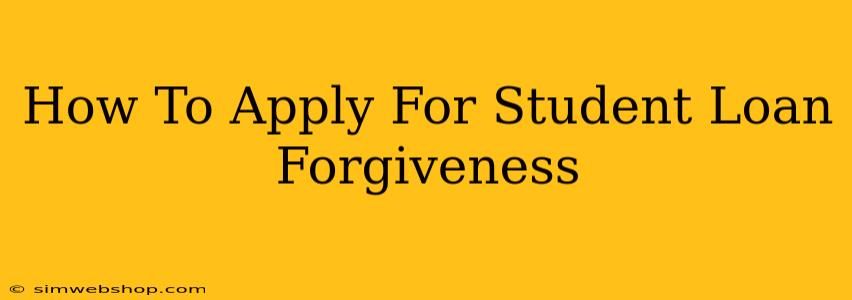Navigating the student loan system can feel overwhelming, especially when trying to understand and apply for loan forgiveness programs. This guide will walk you through the process, clarifying the steps involved and highlighting important considerations. Understanding your eligibility is crucial before you begin.
What Types of Student Loan Forgiveness Programs Exist?
Several federal student loan forgiveness programs exist, each with its own eligibility requirements and application process. Some of the most common include:
-
Public Service Loan Forgiveness (PSLF): This program forgives the remaining balance on your Direct Loans after you've made 120 qualifying monthly payments while working full-time for a qualifying employer. Key requirements include working for a government organization or a non-profit 501(c)(3) organization.
-
Teacher Loan Forgiveness: This program offers forgiveness for teachers who have taught full-time for at least five consecutive academic years in a low-income school or educational service agency.
-
Income-Driven Repayment (IDR) Plans: While not strictly forgiveness programs, IDR plans (like ICR, PAYE, REPAYE, and IBR) can significantly lower your monthly payments and potentially lead to loan forgiveness after 20 or 25 years, depending on the plan. This is often referred to as "forgiveness" but technically is the result of the loan's remaining balance being written off after extended repayment.
-
Total and Permanent Disability (TPD) Discharge: If you are totally and permanently disabled, you may be eligible to have your federal student loans discharged. Strict documentation is required to prove your disability.
Step-by-Step Guide to Applying for Student Loan Forgiveness
The application process varies depending on the program. However, several general steps apply across most programs:
1. Determine Your Eligibility: Carefully review the specific requirements for the program you're interested in. This is the most critical step! Failing to meet the eligibility criteria will result in a denied application.
2. Gather Necessary Documentation: Depending on the program, you'll need documentation such as:
- Proof of employment: For PSLF and Teacher Loan Forgiveness, you'll need documentation proving your employment at a qualifying employer.
- Tax returns: Income-driven repayment plans require income verification.
- Disability documentation: For TPD discharge, you'll need comprehensive medical documentation from your physician.
3. Complete the Application: Each program has its own application form and process. Be sure to complete all sections accurately and thoroughly. Inaccurate information can lead to delays or denial.
4. Submit Your Application: Submit your completed application and all supporting documentation through the appropriate channels. Keep copies of everything for your records.
5. Track Your Application: After submitting your application, track its status online or by contacting the relevant agency. Be patient, as the process can take time.
Important Considerations
- Consolidation: Consolidating your federal student loans might be necessary to participate in some forgiveness programs.
- Certification: Many programs require annual certification of employment. Ensure you complete this step to maintain your eligibility.
- Professional Help: If you're struggling to navigate the application process, consider seeking assistance from a student loan counselor or financial advisor.
Applying for student loan forgiveness can be a complex process. By carefully following these steps and understanding the specific requirements of the program you're applying for, you can increase your chances of success. Remember, thorough preparation and accurate documentation are key. Don't hesitate to seek assistance if needed – your financial future is worth it!

